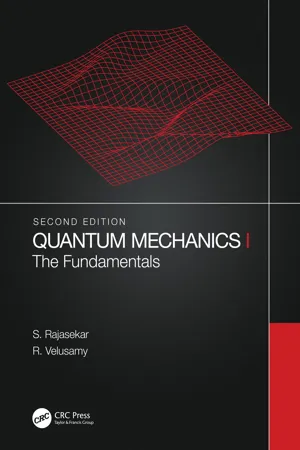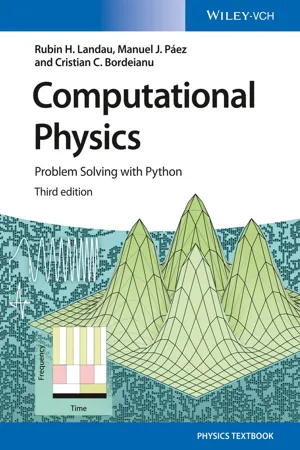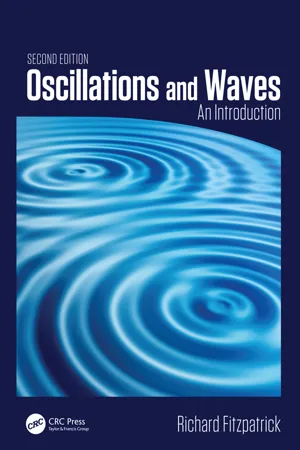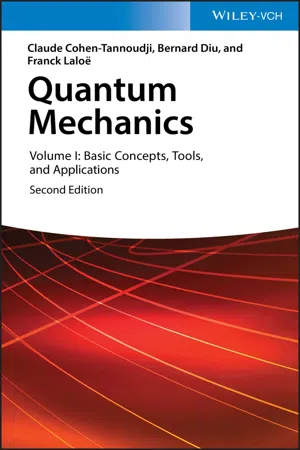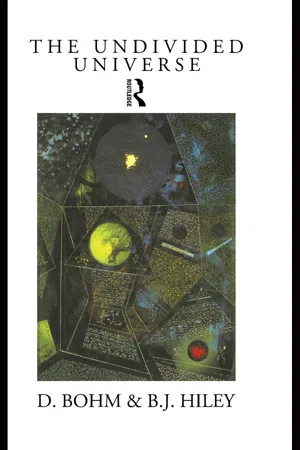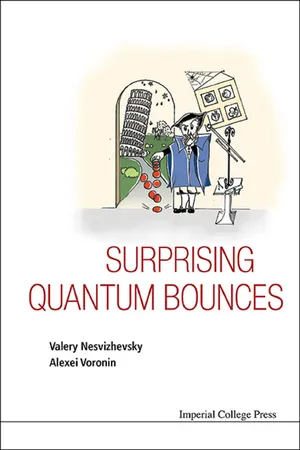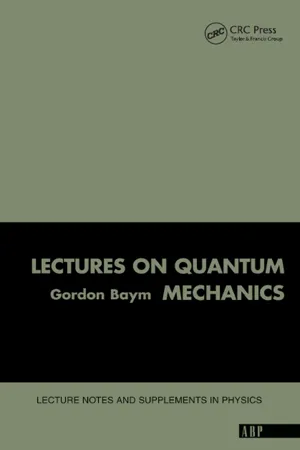Physics
Wave Packet
A wave packet is a short-lived wave that represents a localized disturbance in a medium. It is a mathematical solution to the wave equation and is used to describe the behavior of waves in quantum mechanics and other fields of physics. Wave packets are characterized by their spatial extent and the range of frequencies they contain.
Written by Perlego with AI-assistance
Related key terms
Related key terms
1 of 4
Related key terms
1 of 3
9 Key excerpts on "Wave Packet"
- eBook - ePub
Quantum Mechanics I
The Fundamentals
- S. Rajasekar, R. Velusamy(Authors)
- 2022(Publication Date)
- CRC Press(Publisher)
The behaviour of Coulomb Wave Packets on circular [ 14 ] and elliptical orbits [ 15 ] are tested experimentally on Rydberg atom systems [ 16, 17 ]. Study of Wave Packet is the subject of much current research in atomic, molecular, chemical and condensed matter physics. They are well suited for studying the classical limit of quantum mechanical systems. The advent of short-pulsed lasers made it possible to produce and detect superposition of electron states for many physical systems. Such superposition leads to the formation of localized electron Wave Packets. Solved Problem 2: Find the relation between the phase and group velocities of a Wave Packet obtained by superposing the three waves given by ψ 1 = A e i (k x − ω t), ψ 2 = A 2 e i [ (k + d k) x − (ω + d ω) t ] and ψ 3 = A 2 e i [ (k − d k) x − (ω − d ω) t ]. We. obtain ψ = ψ 1 + ψ 2 + ψ 3 = A e i (k x − ω t) 1 + 1 2 e i (x d k − d ω t) + 1 2 e − i (x d k − d ω t) = A e i (k x − ω t) [ 1 + cos (x d k − d ω t) ] = A e i (k[--=PL. GO-SEPARATOR=--]x − ω t) 1 + cos d k x − d ω d k t. The envelope moves with the velocity d ω / d k and is the group velocity v g. 10.3 Wave Packets and Uncertainty Principle In quantum mechanics, a particle is described by a Wave Packet ψ (x, t). The Wave Packet surrounds the position of the classical particle. The particle may be found anywhere within the region with a probability density | ψ (x, t) | 2. This implies that the position of the particle is indeterminate within the domain of the Wave Packet. A similar argument for the momentum wave function ϕ (p, t) says that the momentum of the particle is also indeterminate within the limits of ϕ (p, t). Since ψ (x, t) and ϕ (p, t) are related by Fourier transforms the squaring of the Wave Packet in one domain will elongate in the other domain as space domain and momentum domain have inverse relationship - eBook - ePub
Interpreting Quantum Mechanics
A Realistic View in Schrodinger's Vein
- Lars-Göran Johansson(Author)
- 2016(Publication Date)
- Routledge(Publisher)
But a Wave Packet can transmit information. The mathematically simplest form to handle is the minimum uncertainty Wave Packet. The signal velocity is the group velocity of the Wave Packet and it is defined as v g = 2 π (d f d k) k = k 0 (4.24) where k 0 refers to the average wave number in the Wave Packet (McGervey, 1971, p. 116). For a matter Wave Packet this becomes v g = (d E d p) p = p 0 = p 0 c 2 E 0 = v 1 (4.25) which is just as it should be. The phase velocity of equations (4.20) – (4.23) is the average phase velocity in the Wave Packet and it must be assumed that the spread around this value is small in order to get a Wave Packet. The frequencies f 0 and f 1 in equations (4.18) – (4.22) are the average frequencies, in different frames, of the Wave Packet. The picture is that of rather 'amorphous' object made up of an indefinite number of vibrations of slightly different frequencies. The reason why this object is usually referred to as a particle is that it interacts as one inseparable whole at a rather well-localised places in space. The wave description is appropriate when and only when discussing its motion, whereas in interactions we use the particle picture. As the Wave Packet is composed of many plane waves with infinite extension the one-dimensional case can be expressed as Ψ (x, t) = ∫ − ∞ ∞ G (k) exp [ − i k (x - v p t) ] d k (4.26) where G (k) is the envelope function. If, for the sake of simplicity, we chose a Gaussian function for G (k) we will get Ψ (x, t) = ∫ − ∞ ∞ exp (- (k - k 0) 2 a) exp [ − i k (x - v p t) ] d k (4.26) where k 0 is the mean wave number in the Wave Packet. The rms-width of this Wave Packet is proportional to √a - eBook - ePub
- Daniel D. Pollock(Author)
- 2020(Publication Date)
- CRC Press(Publisher)
5 waves, it could represent a corpuscle of light. A stream of such corpuscules, or quanta, would give optical results in conformity with the classical geometric optics. However, because each packet may be constructed from the superposition of waves, this model might also account for those properties of light that must be explained by waves.In a similar way, an electron may also be considered to be such a Wave Packet made of matter waves. In this case, an electron with an energy of 1 eV would have a wavelength of 1.24 x 10-4 cm and a frequency of 2.4 x 1014 /s associated with it.Now, consider the behavior of these packets. A packet will be observed to move in its direction of propagation with a group velocity, vg . The individual waves within the group may move with another velocity, their phase velocity, v. Assume that the waves have the properties of particles. Using Equation 1-6,
and substituting Einstein’s relationship between energy and mass, m, for the energy, givesE = h v ;v =E h(2-3) v =mc 2h(2-4) in which c is the velocity of light. This neglects any relativistic changes in mass at very high velocities. The moving particle, or packet, will have a momentum, p. Assume that the packet has a wavelength, λ, associated with it because of its energy-frequency relationship. Assume further that this wavelength and the momentum of the particle are related to each other asλ =h p(2-5) This is the de Broglie equation and is derived and discussed more fully in Section 2.3 . The factor p (the momentum of a particle) is equal to the product of its mass, m, and its velocity, vp - eBook - ePub
Computational Physics
Problem Solving with Python
- Rubin H. Landau, Manuel J. Páez, Cristian C. Bordeianu(Authors)
- 2015(Publication Date)
- Wiley-VCH(Publisher)
22 Wave Equations II: Quantum Packets and ElectromagneticThis chapter continues the discussion of the numerical solution of wave equations begun in Chapter 21 , now to equations that require algorithms with a bit more sophistication. First, we explore quantum Wave Packets, which have their real and imaginary parts solved for at slightly differing (split) times. Then, we explore electromagnetic waves, which have the extra complication of being vector waves with interconnected E and H fields, which also get solved for at split times.22.1 Quantum Wave Packets
Problem An experiment places an electron with a definite momentum and position in a 1D region of space the size of an atom. It is confined to that region by some kind of attractive potential. Your problem is to determine the resultant electron behavior in time and space.22.2 Time-Dependent Schrödinger Equation (Theory)
Because the region of confinement is the size of an atom, we must solve this problem quantum mechanically. Because the particle has both a definite momentum and position, it is best described as a Wave Packet, which implies that we must now solve the time-dependent Schrödinger equation for both the spatial and time dependence of the Wave Packet. Accordingly, this is a different problem from the bound state one of a particle confined to a box, considered in Chapters 7 and 9 , where we solved the eigenvalue problem for stationary states of the time-independent Schrödinger equation.We model an electron initially localized in space at x = 5 with momentum k0 ( = 1 in our units) by a wave function that is a Wave Packet consisting of a Gaussian multiplying a plane wave:The position as a function of time of a localized electron confined to a square well (computed with the codeFigure 22.1SqWell.py - eBook - ePub
Oscillations and Waves
An Introduction, Second Edition
- Richard Fitzpatrick(Author)
- 2018(Publication Date)
- CRC Press(Publisher)
CHAPTER 11Wave Mechanics
11.1 INTRODUCTIONAccording to classical physics (i.e., physics prior to the 20th century), particles and waves are distinct classes of physical entities that possess markedly different properties. For instance, particles are discrete, which means that they cannot be arbitrarily divided. In other words, it makes sense to talk about one electron, or two electrons, but not about a third of an electron. Waves, on the other hand, are continuous, which means that they can be arbitrarily divided. In other words, given a wave whose amplitude has a certain value, it makes sense to talk about a similar wave whose amplitude is one third, or any other fraction whatsoever, of this value. Particles are also highly localized in space. For example, atomic nuclei have very small radii of order 10−15 m, whereas electrons act like point particles (i.e., they have no discernible spatial extent). Waves, on the other hand, are non-localized in space. In fact, a wave is defined as a disturbance that is periodic in space, with some finite periodicity length (i.e., wavelength). Hence, it is fairly meaningless to talk about a disturbance being a wave unless it extends over a region of space that is at least a few wavelengths in size.The classical scenario, just described, in which particles and waves are distinct phenomena, had to be significantly modified in the early decades of the 20th century (Gasiorowicz 1996). During this time period, physicists discovered, much to their surprise, that, under certain circumstances, waves act as particles, and particles act as waves. This bizarre behavior is known as wave-particle duality. For instance, the photoelectric effect (see Section 11.2 ) shows that electromagnetic waves sometimes act like swarms of massless particles called photons. Moreover, the phenomenon of electron diffraction by atomic lattices (see Section 11.3 ) implies that electrons sometimes possess wave-like properties. Wave-particle duality usually only manifests itself on atomic and sub-atomic length-scales [i.e., on lengthscales less than, or of order, 10−10 m; see Section 11.3 .] The classical picture remains valid on significantly longer lengthscales. Thus, on macroscopic lengthscales, waves only act like waves, particles only act like particles, and there is no wave-particle duality. However, on atomic lengthscales, classical mechanics, which governs the macroscopic behavior of massive particles, and classical electrodynamics, which governs the macroscopic behavior of electromagnetic fields—neither of which take wave-particle duality into account—must be replaced by new theories (Dirac 1982). The theories in question are called quantum mechanics and quantum electrodynamics, respectively. In this chapter, we shall discuss a simple version of quantum mechanics in which the microscopic dynamics of massive particles (i.e., particles with finite mass) is described entirely in terms of wavefunctions. This particular version of quantum mechanics is known as wave mechanics. - eBook - ePub
Quantum Mechanics, Volume 1
Basic Concepts, Tools, and Applications
- Claude Cohen-Tannoudji, Bernard Diu, Franck Laloë(Authors)
- 2020(Publication Date)
- Wiley-VCH(Publisher)
For example, when one is dealing with a macroscopic particle (and the example of the dust particle discussed in Complement B I shows how small it can be), the uncertainty relation does not introduce an observable limit on the accuracy with which its position and momentum are known. This means that we can construct, in order to describe such a particle in a quantum mechanical way, a Wave Packet whose characteristic widths Δx and Δp are negligible. We would then speak, in classical terms, of the position x M (t) and the momentum p 0 of the particle. But then its velocity must be. This is indeed what is implied by formula (C-32), obtained in the quantum description: in the cases where Δx and Δp can both be made negligible, the maximum of the Wave Packet moves like a particle that obeys the laws of classical mechanics. Comment: We have stressed here the motion of the center of the free Wave Packet. It is also possible to study the way in which its form evolves in time. It is then easy to show that, if the width Δp is a constant of the motion, Δx varies over time and, for sufficiently long times, increases without limit (spreading of the Wave Packet). The discussion of this phenomenon is given in Complement G I, where the special case of a Gaussian Wave Packet is treated. D. Particle in a time-independent scalar potential We have seen, in § C, how the quantum mechanical description of a particle reduces to the classical description when Planck’s constant h can be considered to be negligible. In the classical approximation, the wavelike character does not appear because the wavelength associated with the particle is much smaller than the characteristic lengths of its motion. This situation is analogous to the one encountered in optics. Geometrical optics, which ignores the wavelike properties of light, constitutes a good approximation when the corresponding wavelength can be neglected compared to the lengths with which one is concerned - eBook - ePub
The Undivided Universe
An Ontological Interpretation of Quantum Theory
- David Bohm, Basil J. Hiley(Authors)
- 2006(Publication Date)
- Routledge(Publisher)
which corresponds to a suitable Wave Packet (describing, for example, the position of a pointer). The initial wave function of the combined system is then(6.2)As a result of the interactions, this wave function is modified and it becomes(6.3)where the On are the eigenvalues of the operator O. After the time Δt when the interaction is over, we obtain(6.4)If the interaction is strong enough to satisfy equation (2.5 ), then the will represent distinct and non-overlapping packets that correspond to the various possible results of the measurement.It is clear from (6.3 ) that during the period of interaction, the various components of the wave function will overlap and interfere. The amplitude of the wave function will then become a very complex and rapidly fluctuating function of x and y and, of course, the time as well. The quantum potential will evidently be correspondingly complicated so that the motion of the particle becomes difficult to predict in much the same way as happened in the case of transitions between stationary states discussed in chapter 5 . However, when the Wave Packets have definitely separated, the apparatus particle y must have entered one of them, say m, in which it remains indefinitely, since the probability of being between packets is zero. From then on, the action of the quantum potential (and, of course, the guidance condition) on the particles will be determined only by the packet because all the other packets (which do not overlap this one) will not contribute to it. So at least as far as the particles are concerned, we may ignore all the other packets and regard them as constituting inactive or physically ineffective information in the sense discussed in chapter 5 . Here it must be emphasised that, as was shown for the transition processes for example, this will still happen even when there is some spatial overlap between ψm (x) and the remaining packets ψn (x). This is because of the multidimensional nature of the wave function of the combined system, which implies that the product, and any other product, say - eBook - ePub
- Valery Nesvizhevsky, Alexei Voronin(Authors)
- 2015(Publication Date)
- ICP(Publisher)
It is said that the function is an eigenfunction of a momentum operator, while is an eigenvalue of a momentum operator.Let us try to construct a given wave-packet as a superposition of waves (2.3) with different momenta . An important Fourier theorem tells us how to construct a given wave-packet from plane waveswith coefficients equal:Exercise 2.6. Verify that the following equality is valid:What is a physical sense of the coefficient ?An answer to this question follows from the probabilistic interpretation of the modulus square of a wave-function (an interested reader could try to motivate it). It consists of the statement that the modulus square of this coefficient |C (p )|2 stands for the probability to observe amomentum valuein a state Ψ0 . We see that the coefficient characterizes the same state Ψ0 , but it calculates a momentum distribution instead of calculating a spatial distribution.A momentum distribution is an equivalent description of a quantum state; it is said that the coefficient C (p ) gives a wave-function in the momentum representation .Exercise 2.7.We write down the solution: The width of the momentum distribution is:Find the momentum distribution in a Gaussian-type wave-packet (2.13).The above expression (2.27) is very similar to the fundamental expression (2.1). It shows that a wave-packet with the spatial width σ could be thought of as a superposition of plane waves. Each plane wave contributes to the wave-packet with a certain weight. The width of the distribution of these weights is ћ /σ .A physical meaning of the expression (2.26) is straightforward: the smaller the spatial width of a wave-packet, the larger its spreading in the momentum space. This momentum dispersion of a wave-packet “explains” the spreading of an initially localized wave-packet. Indeed, the corresponding velocity distribution width is equal Δv = Δp /m = ћ /(mσ ). Thus the rate of spreading is inversely proportional to the spatial size σ and the inertial mass m - eBook - ePub
- Gordon Baym(Author)
- 2018(Publication Date)
- CRC Press(Publisher)
Chapter 9 POTENTIAL SCATTERINGWave PacketS 1We want to consider the scattering of particles by a fixed short-ranged potential; this excludes the case of a Coulomb potential, which requires separate treatment. Suppose, as in Fig. 9-1 , that the source of particles is located far to the left of the target, and that a particle emitted by the source at early time t0 is in a Wave Packet stateψ(=r ,)t 0∫.d 3k(32 π)ei k ⋅ ra k(9-1) We assume that this Wave Packet is localized well out of the range of the potential; on the other hand we assume that akis reasonably sharply peaked about a wave vector k0 , as in Fig. 3-3 . The Wave Packet then travels with velocity ħk0 /m toward the target. Our problem is to find the wave function ψ(r, t) at a time after the particle has interacted with the target.Fig. 9-1Wave Packet of average momentum ħk0 incident on a target.The method for solving this problem is very similar to that used to solve the analogous one-dimensional problem of the reflection and transmission of Wave Packets by potential barriers. First we construct the exact eigenstates, ψk(r), of the potential problem. These satisfy()ħ 22 m∇ 2+E kψ k( r )= v( r )ψ k( r ),(9-2) where Ek = ħ2 k2 /2m. All values of Ek > 0 are possible eigenvalues. Then we expand ψ(r, t0 ) in terms of these eigenstatesψ(=r ,)t 0∫d 3k(32 π)ψ k( r )A k.(9-3) Only states with energy E > 0 enter this expansion, since the wave functions of the bound states of the potential go to zero rapidly at great distances from the potential. Now not all eigenfunctions with E > 0 enter the expansion (9-3 ); the wave function, ψ(r, t), consists of a part incident on the target plus a part that has been scattered by the target. This latter part is a wave moving outward from the target. Therefore, the eigenfunctions that we need in (9-3 ) are those in the form of an incident plane wave plus an outgoing scattered wave. Once we have determined the expansion (9-3 ), then, because the ψk are energy eigenfunctions, at any later time ψ
Index pages curate the most relevant extracts from our library of academic textbooks. They’ve been created using an in-house natural language model (NLM), each adding context and meaning to key research topics.
Explore more topic indexes
Explore more topic indexes
1 of 6
Explore more topic indexes
1 of 4
